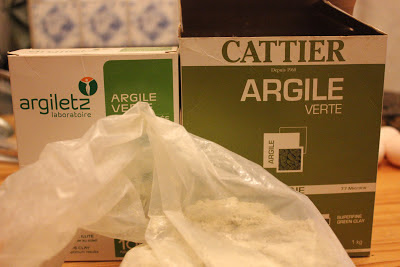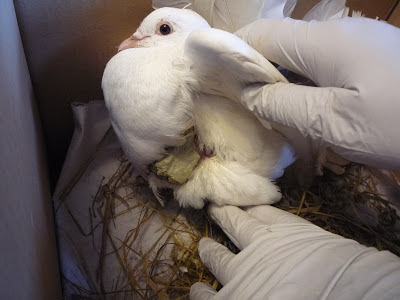Part One of this piece on the identification, life-cycle and lifestyle of the tick can be found here: Trying to play Sherlock Holmes, from the usual demeanour and habits of this young fantail, I gathered she had picked up this adult female tick, whilst foraging for knot grass in the muddy farm lane at the front of the house.
Method
The idea of using Essential oil of Tea Tree is several-fold in that it has the properties of an anaesthetic, antibacterial, antiviral, antiseptic and antimicrobial. The anaesthetic properties, making the tick drowsy, stop it from feeding and therefore aid in helping its release. You can refer to Part One of this article for further explanations.
As the tick
will be feeding on your bird as you are treating it, then whatever you
use to treat it will pass into the bird. Using an essential oil like tea
tree topically on the tick is not dangerous for the bird. In fact Tea
Tree is one of the rare essentially oils which in emergency may be used
in neat form upon the bird read more

You
will in fact see the bird smack its beak as it tastes the tea tree in
its mouth. This is quite normal and something you'd also expect to see
if you treated the bird itself for an infection transdermally through
the soles of the feet. A further reminder that whatever you put on the
skin ends up in the body.

I
used an organic cotton bud to apply the Tea Tree, placing a couple of
drops of pure organic essential oil onto it and then applying it to the
body of the tick. I then waited a couple of minutes to allow the tick to
become anaesthetised.

I
then took a pair of tweezers and held the tick as near to the point of
entry into the pigeon as possible, being careful not to trap any of the
pigeons feathers! I gently began to pull the tick slowly away from the
wound in a direction, which would keep the tick at right angles to the
bird. This way, I hoped to avoid twisting the tick and causing it to
leave its mouth-parts embedded in the pigeon.

I
also held the area around the wound quite firmly with my finger, so as
to prevent the pigeon's skin being pulled, rather than the tick. I kept
talking reassuringly to the pigeon all the time I was doing this, as it
is quite an unpleasant operation, even though the area will be
anaesthetised, by both the tick and the Tea Tree! Pigeons are very
intelligent birds and they do have quite a good rapport with humans,
mine actually walk down the garden and knock on the kitchen window if
they have a problem (this is not just me being fanciful, friends with
pigeons have told me the same). There is a bond of trust between me and
my pigeons, so they need to know that what I am doing is supposed to
help.

N.B. (If the tick seems to still be hanging on tightly, then apply the cotton bud with the Tea Tree again.)

After another couple of tugs it came
away. Here you can see me holding it so as to show the 'head'. You can
see it has left behind quite a wound on the pigeon, which now needed to
be cleaned up.
I used a fresh cotton bud dipped in a small bowl of warm water with two drops of Tea Tree dispersed on the surface. If you are worried about infection of any sort then you can use the Tea Tree neat on the cotton bud but do not use more than a couple of drops. Keep the pigeon under observation and treat with Tea Tree again the next day. This wound however, looked clean and indeed the pigeon seemed none the worse for its ordeal.

A Word About Essential Oils
In
general terms, when using essential oils I either use them dispersed on
the surface of a bowl of water, to create an antiseptic and painkilling
wash for wounds read more
or diluted in one teaspoon of carrier oil and I never use more than 3
drops per day on a single bird. When using an extremely strong
antimicrobial, such as oregano essential oil, I would only use one drop,
diluted in one teaspoon of carrier oil and administer it transdermally,
through the soles of the feet.
Now if you'd like to sit back and watch the film:
Thanks
for dropping by and if you have enjoyed this piece and found it useful
think about sharing it and also may be about joining this blog. Please
also feel free to ask questions or make comments in the section below.
For anyone wishing for links to any of the material I read when researching ticks, please just ask.
All the very best,
Sue
RELATED POSTS
 Scaly Leg Mite Infestations What To Do Part 2
Scaly Leg Mite Infestations What To Do Part 2
I look at the options both medicinal and nutritional for dealing with this microscopic mite ...read more
Stress
comes for all sorts of reasons to an organic flock and if not treated
within 24 hours, if it's a bad attack, it can be fatal...read moreScaly Face Mite Infestations Treatment Part 3
If you haven't this miraculous substance already in your pantry then I
advise you to get some, both for your own and your poultry's health...read more

Stress - When? Why? Whom? Identification, causes and those most at risk
Common Poultry Lice identification, life cycle and major infestation periods
Menacanthus
stramineusare ectoparasites, thus living on the skin...with a short
life span, which in adult form, is from 2 to 3 weeks read more
Common Poultry Lice - Treatment and Prevention
When
you apply any sort of viscous carrier oil to a louse, the spiracles,
pores through which it breathes, become blocked, however, read more
Ticks - Identification, life cycle and lifestyle
I
have to say right from the start the more I read about ticks the more
confused I get. There is a volume of information floating about...read more
Comprehensive Guide to Red Mite Identification & Assessment Part 1
In the following two part articles I set out the information I used and protocols I created from reading through the available research...read moreRed Mite Part 2 Prevention & 3 Cures: Essential Oil, Fire, Steam
Because I have access to all three Fire, Steam and Essential Oils, I
like to use a combination of all three but any one of them used alone ...read more
RETURN TO CONTENTS PAGE
© 2014 Sue Cross





































